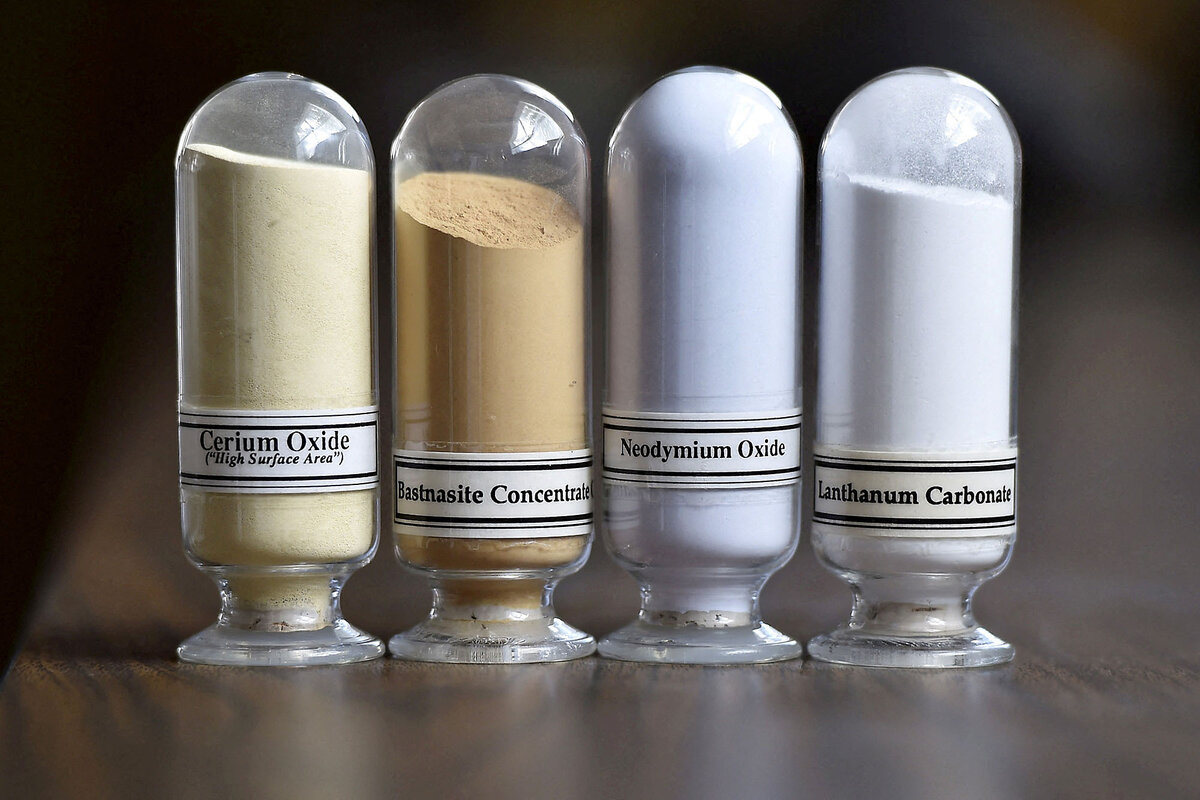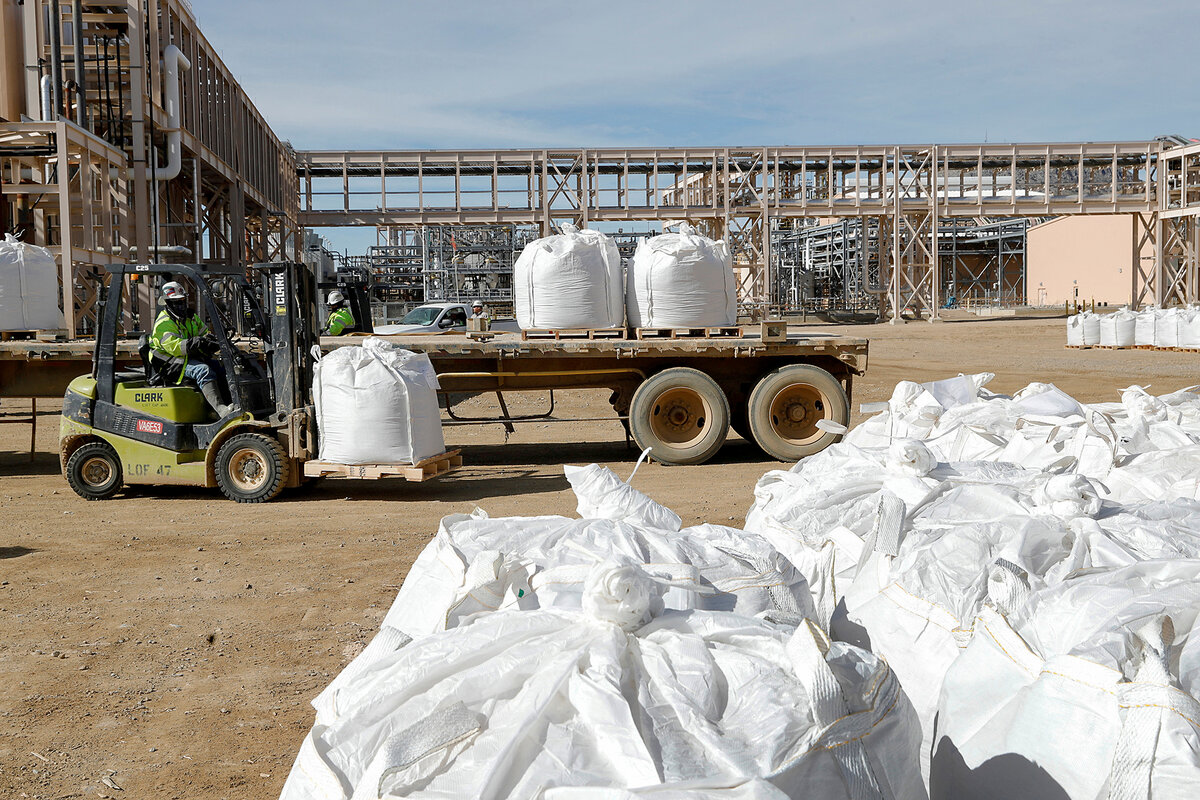There’s one rare earths mine in the US. How that might change soon.
Loading...
On an arid swath of the Mojave Desert, on the California side of the border with Nevada, sits the only facility in America that mines rare earth minerals – materials policymakers across the political spectrum agree are necessary for the economy and national defense.
The mine is called Mountain Pass. The minerals hold a group of elements near the bottom of the periodic table called lanthanides, which are used in everything from drones and missiles to electric vehicles and laptop screens.
And both – the facility and the bits of earth it extracts – are getting a lot of attention. That’s because China, which controls 60% of the world’s rare earth element extraction and almost all its processing, has put new restrictions on the export of many of these metals. The move has rattled economists, manufacturers, and security experts. Rare earths, along with other critical minerals, have been called the “new oil,” the geological necessities of modern economies and warfare. According to the U.S. Geological Survey, the United States gets around 70% of its rare earth imports from China.
Why We Wrote This
Chinese restrictions on exports of rare earth minerals – which have critical military and commercial uses – are spurring calls for increased U.S. production. Reestablishing that domestic supply chain has strategic importance and ecological risks.
“It’s difficult to imagine any manufacturing or industrial supply chain that doesn’t, in one way, shape, or form, depend on these materials,” says Matt Sloustcher, chief communications officer at MP Materials, the company that reopened the 70-year-old Mountain Pass mine in 2017. “There is a consensus that we need to have capacity here.”
But shifting the rare element supply chain back to the U.S. is complicated, despite the fact that a bipartisan array of lawmakers has been worried about the issue for years. The industry moved to China in the 1990s to benefit from lower costs, lax labor laws, and nonexistent environmental protections, according to many analysts.
Reestablishing a domestic process means that companies will have to figure out how to make a cleaner extractive industry – or the government will have to reduce environmental and permitting regulations. Last month, President Donald Trump issued an executive order to speed up mineral mining projects by expediting the permitting process; he has also directed agencies to sunset environmental regulations that could impact energy projects.
For its part, MP Materials boasts of its sustainability record. Mr. Sloustcher says that environmental analyses of Mountain Pass demonstrate a far cleaner production process than what happens at Chinese mines. It is now the second-largest rare earth mine in the world, and has the only rare earth refinery in the Western Hemisphere. It has plans to open a battery facility in Texas to process the metals, and says General Motors has agreed to purchase auto components there.
But the vast majority of its minerals are still exported for processing. And while there are multiple U.S. companies working to develop cleaner, next-generation rare earth technology, analysts believe it will still be years before they are able to contribute substantially to the U.S. supply chain.
A priority for Biden and Trump
Both the Biden and Trump administrations have earmarked money to try to secure American access to rare earth elements. In his first term, President Trump worked to speed permitting and released Defense Protection Act spending for rare earth mining. President Joe Biden sent billions of dollars through his two massive spending bills, the Bipartisan Infrastructure Act and the Inflation Reduction Act, to secure battery supply chains. He also directed Defense Production Act spending to secure the minerals. Since 2020, the Department of Defense has allocated more than $439 million to build what it calls a domestic “mine to magnet” supply chain.
Rare earths, after all, are used in military equipment from sonars to fighter jets, radars to submarines. They are in precision weapons, electric drone batteries, flight control systems, and more.
“The US military is existentially dependent on them,” says Buz Barstow, a Cornell University biological engineer who is involved in next-generation rare earths technology.
President Trump issued an executive order April 15 directing the Department of Commerce to investigate the rare earth elements supply chain. The president’s comments about taking control of Greenland, many analysts say, have a lot to do with the rare earth mining potential under that territory’s ice sheet.
Ecological drawbacks – and potential solutions
Part of the complication in mining rare earth elements comes from the fact that they aren’t actually rare at all. To the contrary, they are abundant in Earth’s crust. But they pose mining and processing challenges because they tend to be dispersed widely, rather than found in concentrated deposits, and are extremely difficult to separate.
To extract them, most companies use large, open-pit mines, which environmentalists say are ecologically damaging. Processing them has traditionally required toxic, highly corrosive substances that can leach into waterways and soil.
Rare earth concentrations also tend to happen alongside uranium – a geophysical reality that has led to radiation concerns at many mines, says Raquel Dominguez, circular economy policy advocate at the environmental group Earthworks. “Extracting them is often extremely dangerous,” she notes.
The U.S. was largely self-sufficient when it came to rare earth minerals until the 1990s. And when companies moved to China, Dr. Barstow says, many in the industry figured that it would be easy to reshore the process when they wanted.
But time went on, and the industry remained in China.
Dr. Barstow became interested in rare earth elements in 2011, during the Obama administration, when the Chinese government first reduced its exports of the elements.
“I think the reason they did it was to show that they could,” he says. “I remember thinking that maybe biology could do something to help.”
With a team of scholars, he began investigating the concept of “biomining,” or using genetically adapted microorganisms to dissolve minerals, separate metals, and replace the traditional toxic processing of rare earths. He found that the process worked. One of his postgraduate students has since commercialized the approach to rare earth elements. Dr. Barstow received a National Science Foundation grant last year to create a catalog of microorganisms and genes and how they interact with minerals. Other startups around the U.S. are also focused on finding new ways to process rare earth elements in a more ecologically friendly manner, often with synthetic biology.
Rare earth mining’s role in the green energy transition
For its part, MP Minerals touts its sustainability measures, like water recycling and secure waste storage, and points out that the mine meets stringent California environmental regulations.
Some environmentalists, including Ms. Dominguez, are skeptical about how green any extractive industry can actually be. A mine’s impact on the surrounding ecology and people can be severe, and, in the U.S., disproportionately impact Indigenous people, she says. Rather than trying to use technology to green a dirty industry, Americans should rethink consumption patterns, she suggests.
Yet even in the environmental world, there are many supporters of rare earth mining, in large part because the minerals are essential for decarbonization. They’re used in everything from solar panels to energy storage batteries to EVs. Without rare earth minerals, there is no green energy.
“Mining is an underappreciated factor in the clean energy transition,” says Gernot Wagner, climate economist at Columbia University’s business school.








